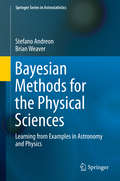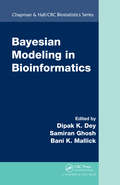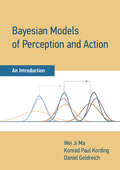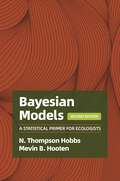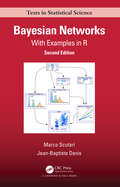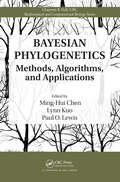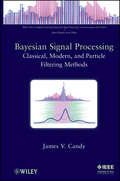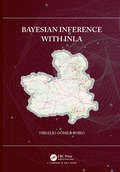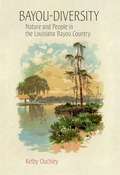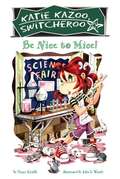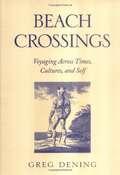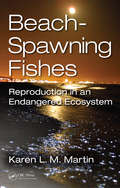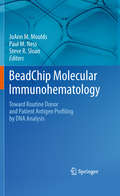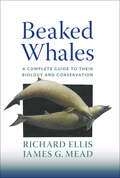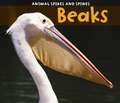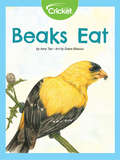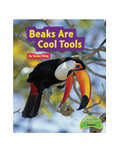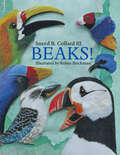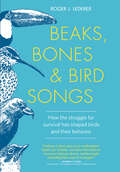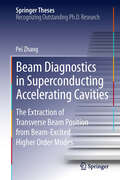- Table View
- List View
Bayesian Methods for Ecology
by Michael A. MccarthyThe interest in using Bayesian methods in ecology is increasing, however many ecologists have difficulty with conducting the required analyses. McCarthy bridges that gap, using a clear and accessible style. The text also incorporates case studies to demonstrate mark-recapture analysis, development of population models and the use of subjective judgement. The advantages of Bayesian methods, are also described here, for example, the incorporation of any relevant prior information and the ability to assess the evidence in favour of competing hypotheses. Free software is available as well as an accompanying web-site containing the data files and WinBUGS codes. Bayesian Methods for Ecology will appeal to academic researchers, upper undergraduate and graduate students of Ecology.
Bayesian Methods for the Physical Sciences: Learning from Examples in Astronomy and Physics (Springer Series in Astrostatistics #4)
by Stefano Andreon Brian WeaverStatistical literacy is critical for the modern researcher in Physics and Astronomy. This book empowers researchers in these disciplines by providing the tools they will need to analyze their own data. Chapters in this book provide a statistical base from which to approach new problems, including numerical advice and a profusion of examples. The examples are engaging analyses of real-world problems taken from modern astronomical research. The examples are intended to be starting points for readers as they learn to approach their own data and research questions. Acknowledging that scientific progress now hinges on the availability of data and the possibility to improve previous analyses, data and code are distributed throughout the book. The JAGS symbolic language used throughout the book makes it easy to perform Bayesian analysis and is particularly valuable as readers may use it in a myriad of scenarios through slight modifications. This book is comprehensive, well written, and will surely be regarded as a standard text in both astrostatistics and physical statistics. Joseph M. Hilbe, President, International Astrostatistics Association, Professor Emeritus, University of Hawaii, and Adjunct Professor of Statistics, Arizona State University
Bayesian Modeling in Bioinformatics (Chapman & Hall/CRC Biostatistics Series)
by Bani K. Mallick Dipak K. Dey Samiran GhoshBayesian Modeling in Bioinformatics discusses the development and application of Bayesian statistical methods for the analysis of high-throughput bioinformatics data arising from problems in molecular and structural biology and disease-related medical research, such as cancer. It presents a broad overview of statistical inference, clustering, and c
Bayesian Models of Perception and Action: An Introduction
by Wei Ji Ma Konrad Paul Kording Daniel GoldreichAn accessible introduction to constructing and interpreting Bayesian models of perceptual decision-making and action.Many forms of perception and action can be mathematically modeled as probabilistic—or Bayesian—inference, a method used to draw conclusions from uncertain evidence. According to these models, the human mind behaves like a capable data scientist or crime scene investigator when dealing with noisy and ambiguous data. This textbook provides an approachable introduction to constructing and reasoning with probabilistic models of perceptual decision-making and action. Featuring extensive examples and illustrations, Bayesian Models of Perception and Action is the first textbook to teach this widely used computational framework to beginners.Introduces Bayesian models of perception and action, which are central to cognitive science and neuroscienceBeginner-friendly pedagogy includes intuitive examples, daily life illustrations, and gradual progression of complex conceptsBroad appeal for students across psychology, neuroscience, cognitive science, linguistics, and mathematicsWritten by leaders in the field of computational approaches to mind and brain
Bayesian Models: A Statistical Primer for Ecologists, 2nd Edition
by N. Thompson Hobbs Mevin B. HootenA fully updated and expanded edition of the essential primer on Bayesian modeling for ecologistsUniquely suited to deal with complexity in a statistically coherent way, Bayesian modeling has become an indispensable tool for ecological research. This book teaches the basic principles of mathematics and statistics needed to apply Bayesian models to the analysis of ecological data, using language non-statisticians can understand. Deemphasizing computer coding in favor of a clear treatment of model building, it starts with a definition of probability and proceeds step-by-step through distribution theory, likelihood, simple Bayesian models, and hierarchical Bayesian models. Now revised and expanded, Bayesian Models enables students and practitioners to gain new insights from ecological models and data properly tempered by uncertainty.Covers the basic rules of probability needed to model diverse types of ecological data in the Bayesian frameworkShows how to write proper mathematical expressions for posterior distributions using directed acyclic graphs as templatesExplains how to use the powerful Markov chain Monte Carlo algorithm to find posterior distributions of model parameters, latent states, and missing dataTeaches how to check models to assure they meet the assumptions of model-based inferenceDemonstrates how to make inferences from single and multiple Bayesian modelsProvides worked problems for practicing and strengthening modeling skillsFeatures new chapters on spatial models and modeling missing data
Bayesian Networks: With Examples in R (Chapman & Hall/CRC Texts in Statistical Science #109)
by Marco Scutari Jean-Baptiste DenisBayesian Networks: With Examples in R, Second Edition introduces Bayesian networks using a hands-on approach. Simple yet meaningful examples illustrate each step of the modelling process and discuss side-by-side the underlying theory and its application using R code. The examples start from the simplest notions and gradually increase in complexity. In particular, this new edition contains significant new material on topics from modern machine learning practice: dynamic networks, networks with heterogeneous variables, and model validation. The first three chapters explain the whole process of Bayesian network modelling, from structure learning to parameter learning to inference. These chapters cover discrete, Gaussian, and conditional Gaussian Bayesian networks. The following two chapters delve into dynamic networks (to model temporal data) and into networks including arbitrary random variables (using Stan). The book then gives a concise but rigorous treatment of the fundamentals of Bayesian networks and offers an introduction to causal Bayesian networks. It also presents an overview of R packages and other software implementing Bayesian networks. The final chapter evaluates two real-world examples: a landmark causal protein-signaling network published in Science and a probabilistic graphical model for predicting the composition of different body parts. Covering theoretical and practical aspects of Bayesian networks, this book provides you with an introductory overview of the field. It gives you a clear, practical understanding of the key points behind this modelling approach and, at the same time, it makes you familiar with the most relevant packages used to implement real-world analyses in R. The examples covered in the book span several application fields, data-driven models and expert systems, probabilistic and causal perspectives, thus giving you a starting point to work in a variety of scenarios. Online supplementary materials include the data sets and the code used in the book, which will all be made available from https://www.bnlearn.com/book-crc-2ed/
Bayesian Phylogenetics: Methods, Algorithms, and Applications (Chapman & Hall/CRC Computational Biology Series)
by Ming-Hui Chen Lynn Kuo Paul O. LewisOffering a rich diversity of models, Bayesian phylogenetics allows evolutionary biologists, systematists, ecologists, and epidemiologists to obtain answers to very detailed phylogenetic questions. Suitable for graduate-level researchers in statistics and biology, Bayesian Phylogenetics: Methods, Algorithms, and Applications presents a snapshot of c
Bayesian Signal Processing
by James V. CandyNew Bayesian approach helps you solve tough problems in signal processing with easeSignal processing is based on this fundamental concept--the extraction of critical information from noisy, uncertain data. Most techniques rely on underlying Gaussian assumptions for a solution, but what happens when these assumptions are erroneous? Bayesian techniques circumvent this limitation by offering a completely different approach that can easily incorporate non-Gaussian and nonlinear processes along with all of the usual methods currently available.This text enables readers to fully exploit the many advantages of the "Bayesian approach" to model-based signal processing. It clearly demonstrates the features of this powerful approach compared to the pure statistical methods found in other texts. Readers will discover how easily and effectively the Bayesian approach, coupled with the hierarchy of physics-based models developed throughout, can be applied to signal processing problems that previously seemed unsolvable.Bayesian Signal Processing features the latest generation of processors (particle filters) that have been enabled by the advent of high-speed/high-throughput computers. The Bayesian approach is uniformly developed in this book's algorithms, examples, applications, and case studies. Throughout this book, the emphasis is on nonlinear/non-Gaussian problems; however, some classical techniques (e.g. Kalman filters, unscented Kalman filters, Gaussian sums, grid-based filters, et al) are included to enable readers familiar with those methods to draw parallels between the two approaches.Special features include:Unified Bayesian treatment starting from the basics (Bayes's rule) to the more advanced (Monte Carlo sampling), evolving to the next-generation techniques (sequential Monte Carlo sampling)Incorporates "classical" Kalman filtering for linear, linearized, and nonlinear systems; "modern" unscented Kalman filters; and the "next-generation" Bayesian particle filtersExamples illustrate how theory can be applied directly to a variety of processing problemsCase studies demonstrate how the Bayesian approach solves real-world problems in practiceMATLAB notes at the end of each chapter help readers solve complex problems using readily available software commands and point out software packages availableProblem sets test readers' knowledge and help them put their new skills into practiceThe basic Bayesian approach is emphasized throughout this text in order to enable the processor to rethink the approach to formulating and solving signal processing problems from the Bayesian perspective. This text brings readers from the classical methods of model-based signal processing to the next generation of processors that will clearly dominate the future of signal processing for years to come. With its many illustrations demonstrating the applicability of the Bayesian approach to real-world problems in signal processing, this text is essential for all students, scientists, and engineers who investigate and apply signal processing to their everyday problems.
Bayesian inference with INLA
by Virgilio Gomez-RubioThe integrated nested Laplace approximation (INLA) is a recent computational method that can fit Bayesian models in a fraction of the time required by typical Markov chain Monte Carlo (MCMC) methods. INLA focuses on marginal inference on the model parameters of latent Gaussian Markov random fields models and exploits conditional independence properties in the model for computational speed. Bayesian Inference with INLA provides a description of INLA and its associated R package for model fitting. This book describes the underlying methodology as well as how to fit a wide range of models with R. Topics covered include generalized linear mixed-effects models, multilevel models, spatial and spatio-temporal models, smoothing methods, survival analysis, imputation of missing values, and mixture models. Advanced features of the INLA package and how to extend the number of priors and latent models available in the package are discussed. All examples in the book are fully reproducible and datasets and R code are available from the book website. This book will be helpful to researchers from different areas with some background in Bayesian inference that want to apply the INLA method in their work. The examples cover topics on biostatistics, econometrics, education, environmental science, epidemiology, public health, and the social sciences.
Bayley Scales of Infant and Toddler Development Technical Manual (Third Edition)
by Nancy BayleyThis revision was conducted to improve the quality and to enhance the utility of the instrument. Like its predecessor, the Bayley-III is an individually administered instrument that assesses the developmental functioning of infants and young children 1 month to 42 months of age. The primary purpose of the Bayley-III is to identify children with developmental delay and to provide information for intervention planning. While certain aspects of the BSID-II have been altered and new material has been added, the Bayley-III maintains the original nature and purpose of the Bayley Scales as envisioned by its author, Nancy Bayley.
Bayou-Diversity: Nature and People in the Louisiana Bayou Country
by Kelby OuchleyLouisiana's bayous and their watersheds teem with cypress trees, alligators, crawfish, and many other life forms. From Bayou Tigre to Half Moon Bayou, these sluggish streams meander through lowlands, marshes, and even uplands to dominate the state's landscape. In Bayou-Diversity, conservationist Kelby Ouchley reveals the bayou's intricate web of flora and fauna.Through a collection of essays about Louisiana's natural history, Ouchley details an amazing array of plants and animals found in the Bayou State. Baldcypress, orchids, feral hogs, eels, black bears, bald eagles, and cottonmouth snakes live in the well over a hundred bayous of the region. Collectively, Ouchley's vignettes portray vibrant and complex habitats. But human interaction with the bayou and our role in its survival, Ouchley argues, will determine the future of these intricate ecosystems. Bayou-Diversity narrates the story of the bayou one flower, one creature at a time, in turn illustrating the bigger picture of this treasured and troubled Louisiana landscape.
Be Active (Health and My Body)
by Mari SchuhGrab some friends and play tag. Take a bike ride. Go on a hike. There are so many ways to be active! Lively photos mixed with informative text will explain why we need to be active and inspire every reader to get up and move. Be Active includes a glossary, a read more section, kid-friendly Internet sites, and an index.
Be Nice to Mice! (Katie Kazoo Switcheroo #20)
by Nancy KrulikFourth-grader Katie is concerned when an older girl uses live mice in a science fair project, but when Katie turns into the sixth-grader and has to run the experiment herself, she has a different opinion of the student.
Be a Scientist Notebook: Student Journal (Inspire Science #Grade 2)
by McGraw-Hill EducationNIMAC-sourced textbook
Beach Crossings: Voyaging Across Times, Cultures, And Self
by Greg DeningDistinguished historian / anthropologist Greg Dening here revisits the island beaches of Oceania in an extended essay on first encounters and the peoples they brought together. An imaginative exploration of the symbolic strip where ocean meets island, Dening's meditation reflects upon the bloody history of the Marquesas in the South Pacific: its inhabitants and its combatants, the author's own time spent there and in study of his subject. This is a book to treasure and to reflect upon. First encounters are usually written about as the history of explorers and the anthropology of "others." It is Greg Dening's project to produce a history and anthropology of both, "on the beach," where so many of these exchanges between peoples began. Dening imaginatively reconstructs the first interactions among explorers, missionaries, and natives—mostly in the Marquesas, the primary focus of his scholarly work. He examines fictional accounts of these encounters as well as the written record, revisiting the experiences of Captain Bligh and Gauguin, Melville's seafarers as well as some famous castaways. Each featured beach crossing is prefaced with an introduction placing the encounter in its historical context. Beach Crossings is for Greg Dening a summary work, the apex of a fifty-year career that has taken him across many beaches and oceans. The author of the seminal volume Mr. Bligh's Bad Language, Dening writes here an intensely personal, compelling reflection upon his crossings, his subjects'—and ours.
Beach-Spawning Fishes: Reproduction in an Endangered Ecosystem
by Karen L.M. MartinBeach-spawning fishes from exotic locations on most continents of the world provide spectacular examples of extreme adaptations during the most vulnerable life cycle stages. The beauty, intriguing biology, and importance of these charismatic fishes at the interface of marine and terrestrial ecosystems have inspired numerous scientific studies. Adap
BeadChip Molecular Immunohematology: Toward Routine Donor and Patient Antigen Profiling by DNA Analysis
by Steve R. Sloan Paul M. Ness Joann M. MouldsThis text is a review of molecular immunohematology (MI). It draws from analyses and case studies around the world and details many techniques used in many labs. It is aimed at anyone interested in how MI is changing blood bank and transfusion medicine.
Beaked Whales: A Complete Guide to Their Biology and Conservation
by Richard Ellis James G. MeadThe only book dedicated to the mysterious beaked whale, this beautiful volume combines full-color illustrations with fascinating facts.Beaked whales have been shrouded in mystery for most of the twentieth century. Denizens of deep, remote ocean waters and highly resistant to life in captivity, they have proven notoriously difficult for humans to observe. Over the past few decades, however, scientists have gained a better understanding of this distinct group of cetaceans, deciphering the natural history of the twenty-two beaked whale species. Here, famed artist and naturalist Richard Ellis and leading beaked whale researcher James G. Mead bring these elusive marine mammals into the limelight.Beaked whales’ generous life spans can extend well past 70 years. They spend their decades diving to extreme depths in search of prey, which they capture by expanding their oral cavity suddenly to suck in the squid or fish they are hunting. It appears that these sleek predators may engage in fierce, clandestine aquatic battles, as the bodies of many males are covered in scars. Because many species are only somewhat larger than dolphins, they are often confused with porpoises; however, some larger beaked whale species may grow to 40 feet. These enigmatic and compelling creatures need our help; their numbers are declining, perhaps due to the damaging effects of naval sonar on their sophisticated auditory systems.In Ellis and Mead’s book, the beaked whales finally get their due. The duo provides a combination of captivating stories about the species, original Richard Ellis art, and photos from leading natural history photographers. The result is an accessible, beautiful book—the first of its kind on this unusual group of cetaceans. Meet the beaked whales, and enjoy the fascinating and mysterious world in which they live.
Beaks (Animal Spikes and Spines)
by Rebecca RissmanThis title introduces readers to beaks, how they help animals to survive, and how different they can look.
Beaks Eat
by Amy TaoHave you ever wondered why birds have beaks? They don't have hands like we do, so they need another way to help themselves. Learn all the ways birds use their beaks, and see how different birds have different types of beaks that allow them to catch their meals.
Beaks are Cool Tools (Fountas & Pinnell LLI Red #Level L)
by Susan RingDo birds use their beaks like people use tools? Watch a toucan pick up tiny berries with it's large beak. Or learn how a woodpecker uses it's beak to find grubs inside a tree. How does a flamingo eat under water?
Beaks!
by Sneed B. CollardHow can a toucan fly with such a large, cumbersome beak? A toucan's beak is actually light as a feather due to its honeycomb construction. And not only is it beautiful, but it's an extremely useful tool in foraging for food. Find out more fascinating facts in this remarkably illustrated study of bird beaks. Learn about several different birds, their habitats, and how their beaks are uniquely styled to help them survive. Outstanding 3-D cut-paper illustrations by Robin Brickman create amazingly realistic tableaus of birds in their natural environments with their beaks in action. Back matter includes a comprehensive quiz, a bibliography, and a list of related Web sites.
Beaks, Bones and Bird Songs: How the Struggle for Survival Has Shaped Birds and Their Behavior
by Roger Lederer“Reveals the strange and wondrous adaptations birds rely on to get by.” —National Audubon Society When we see a bird flying from branch to branch happily chirping, it is easy to imagine they lead a simple life of freedom, flight, and feathers. What we don’t see is the arduous, life-threatening challenges they face at every moment. Beaks, Bones, and Bird Songs guides the reader through the myriad, and often almost miraculous, things that birds do every day to merely stay alive. Like the goldfinch, which manages extreme weather changes by doubling the density of its plumage in winter. Or urban birds, which navigate traffic through a keen understanding of posted speed limits. In engaging and accessible prose, Roger Lederer shares how and why birds use their sensory abilities to see ultraviolet, find food without seeing it, fly thousands of miles without stopping, change their songs in noisy cities, navigate by smell, and much more.
Beam Diagnostics in Superconducting Accelerating Cavities: The Extraction of Transverse Beam Position from Beam-Excited Higher Order Modes (Springer Theses)
by Pei ZhangAn energetic charged particle beam introduced to an rf cavity excites a wakefield therein. This wakefield can be decomposed into a series of higher order modes and multipoles, which for sufficiently small beam offsets are dominated by the dipole component. This work focuses on using these dipole modes to detect the beam position in third harmonic superconducting S-band cavities for light source applications. A rigorous examination of several means of analysing the beam position based on signals radiated to higher order modes ports is presented. Experimental results indicate a position resolution, based on this technique, of 20 microns over a complete module of 4 cavities. Methods are also indicated for improving the resolution and for applying this method to other cavity configurations. This work is distinguished by its clarity and potential for application to several other international facilities. The material is presented in a didactic style and is recommended both for students new to the field, and for scientists well-versed in the field of rf diagnostics.

